Music
Trailers
DailyVideos
India
Pakistan
Afghanistan
Bangladesh
Srilanka
Nepal
Thailand
StockMarket
Business
Technology
Startup
Trending Videos
Coupons
Football
Search
Download App in Playstore
Download App
Best Collections
Technology

We&ve aggregated the worldbest growth marketers into one community. Twice a month, we ask them to share their most effective growth tactics, and we compile them into this Growth Report.
This is how you&re going stay up-to-date on growth marketing tactics — with advice you can&t get elsewhere.
Our community consists of 600 startup founders paired with VPof growth from later-stage companies. We have 300 YC founders plus senior marketers from companies including Medium, Docker, Invision, Intuit, Pinterest, Discord, Webflow, Lambda School, Perfect Keto, Typeform, Modern Fertility, Segment, Udemy, Puma, Cameo, and Ritual.
You can participate in our community by joining Demand Curvemarketing webinars, Slack group, or marketing training program.
Without further ado, onto the advice.
Editornote: This is the first of a new series of articles on startup growth tactics in 2019 for Extra Crunch. This first article has been unlocked for all TechCrunch readers.
Don&t abandon email unsubscribers. They&re still useful.
Based on insights from Matt Sornson of Clearbit.
You&ve launched a new feature and want to tell your audience about it. You can send an email to your newsletter subscribers, but how do you reach the 20%+ who unsubscribed? Most people mistakenly consider this audience to be a lost cause.
- Create a custom audience of all newsletter unsubscribers on Facebook.
- Run ads announcing the new feature to that audience.
- Now you&ve reactivated people who at one point had an interest in your product — instead of forever ignoring them.
Tips for effectively working with influencers
Based on insights from Barron Caster of Rev.
- Create a referral system for influencers: Influencers who sign up others get a % of their sales or signups. This makes a mini-pyramid structure and turns your influencers into a salesforce. Why is this important? Some influencers don&t actually sell products, but just sign up tons of other influencers. Find these people.
- Get everything you can out of an engagement (e.g. permission to use them as a testimonial for emails, social proof, etc.).
- Working with influencers is a relationship-building game:
- Actually go to conferences to meet influencers.
- Treat influencers like royalty. Surprise them with gifts like flowers/donuts. $100 to send a gift can pay hefty dividends if they like your brand more and share that with their followers.
- Give influencers a tangible benefit to share with their followers. They care about their followers and want to beneficially incentivize them to click on their link and buy with them.
More tips for working with influencers
Based on insights from Cezar Grigore of Tremo Books.
- Geo rollouts: Your ROI increases when a bunch of influencers in the same category / region share your product within an interval of 2-4 weeks. It gives the impression that everyone is talking about your product.
- Initially focus on influencers with 10-150k audiences. They&re smaller and more willing to accept bartered deals. There are enough influencers in this range willing to work in exchange for a free product. Most may not be producing results, but some work well, bringing in 50-200 customers within 24 hours. As you build up your following and reputation for your brand, it becomes much easier to work with more influential people.
- Itharder to cut deals with bigger influencers (100k-2M). Only about 5-10% of bigger influencers are willing to work on an affiliate basis (e.g. $10/customer).
Overcoming ad blockers that screw up your conversion data
- Ad blockers can block FBtracking libraries and underreport ad conversions (even by 50%). The trick? Consider using the static IMG FB pixel — not the JavaScript one — which ad blockers don&t appear to block. — C.
- Hereanother ad block workaround: You can extract UTM tags from the URL then save them into LocalStorage using JavaScript. Next, send that stored data plus the useron-site conversion behavior to a custom backend that, inherently, will circumvent ad blockers. Just be diligent about ensuring your marketing links all have UTM tags. —Neal O&Grady of Demand Curve
- Remember that the use of ad blockers varies heavily by audience and device type. Depending on who your audience is, ad blockers can either be a huge problem or a non-problem. —Neal O&Grady of Demand Curve
- So, for example, few people on mobile have ad blockers. Not much of a problem there.
- However, on desktop, up to ~75% of millennial gamers and techies may have it installed.
- In contrast, on desktop, maybe only 25% of middle-aged Americans outside of tech hub cities may have it installed.
- These are hand-wavy numbers. Google for specifics.
- Details
- Category: Technology
Read more: How to work with top influencers and avoid ad blockers
Write comment (93 Comments)Amazon is testing an easier way for people to leave product feedback with the launch of one-tap ratings. The change is meant to encourage those who don&t have the time, energy or interest in writing reviews to still share their opinion about the product, which benefits the larger Amazon community of shoppers who are reliant on ratings and reviews to make better purchasing decisions.
If you have access to the new experiment, you&ll be able to just tap once to leave your star rating on any item, without having to fill out additional fields like a review title and written review, as previously required.
You&ll also be able to access these one-tap ratings from a number of places, including the &Your Orders& page on Amazon where you can tap the &Write a Review& button; by going to a product page directly; or by responding to solicitations sent to you from Amazon or those that appear on the homepage when you log in.
The process of leaving a one-tap review is extremely simple — you just select the star rating and you&ll then see a green checkmark confirming the submission.
Only those one-tap ratings from Verified Purchases will contribute to the productoverall star rating. You&re also able to expand on your feedback later on, if you choose, by adding a review, photos or video.

The new feature could go a long way toward being able to collect feedback from a larger number of online consumers, as many don&t bother with writing reviews. It also could help balance out the ratings with feedback from real shoppers, as opposed to those who may have been incentivized or paid to leave reviews.
Thatagainst Amazon policy, of course, and is a practice the retailer has been cracking down on for years — including by outright banning incentivized reviews, by way of multiple lawsuits, fines and through suspensions of seller accounts. But there are still services out there offering to boost a productAmazon reviews through less-than-official tactics. And there are products on Amazon that continue to have suspiciously positive reviews, ranging from weight loss pills to Bluetooth headphones.
Flooding those products with legit reviews from real customers could bring about a more accurate rating, even if Amazon isn&t able to fully flush the scammers from its review community.
The new ratings test is showing both online and in the mobile app worldwide. Not everyone will see the feature at this time, as some customers will be in a control group.
Amazon confirmed the new feature is an experiment, not a public launch.
&We are testing a feature that allows customers to leave feedback easily while also helping shoppers get authentic customer ratings on products from a broader set of shoppers,& an Amazon spokesperson said.
- Details
- Category: Technology
Read more: Amazon tests a one-tap review system for product feedback
Write comment (93 Comments)The Daily Crunch is TechCrunchroundup of our biggest and most important stories. If you&d like to get this delivered to your inbox every day at around 9am Pacific, you can subscribe here.
1. Another high-flying, heavily funded AR headset startup is shutting down
In an email obtained by TechCrunch, Daqri — which built enterprise-grade AR headsets — told its customers that itpursuing an asset sale and will be shutting down its cloud and smart-glasses hardware platforms by the end of September.
Daqri is the latest heavily funded, enterprise-focused augmented reality startup to struggle or shut down recently, with Osterhout Design Group unloading its AR glasses patents earlier this year and Meta selling its assets after it ran out of cash.
2. Apple introduces a ‘grace period& for lapsed App Store subscriptions
Previously, any lapse in payment could cut off the customer from an appsubscription-based features. Now, Apple says developers will have the option to offer a &grace period,& giving Apple more time to collect payment.
3. SmileDirectClub makes its debut on the public market
Teeth-straightening company SmileDirectClub rang the opening bell at Nasdaq yesterday, marking its first day of trading as a public company.

4. Element AI raises $151M on a $600-700M valuation to help companies build and run AI solutions
Element AI has built an artificial intelligence systems integrator of sorts, designed to help other companies develop and implement AI solutions.
5. WalmartVudu adds Family Play feature so viewers can skip sex, violence and substance abuse
Vudu viewers can turn filters on and off for sex/nudity, violence, substance abuse and language. In the first three instances, Vudu will skip the relevant scenes, and in the case of strong language, it will mute the dialog.
6. Sidewalk Labs spins out urban data-gathering tool Replica into a company
The Replica tool grew out of Model Lab, a project started two years ago to investigate modeling as a way to address urban problems — specifically the fact that public agencies don&t have all the information needed to understand the connections between transportation and land use.
7. How the Valley can get philanthropy right with former Hewlett Foundation president Paul Brest
When he was named president of the William - Flora Hewlett Foundation, Brest applied the rigor of a legal scholar, not just to his own institutionpractices, but to those of the philanthropy field at large. (Extra Crunch membership required.)

- Details
- Category: Technology
Read more: Daily Crunch: AR startup Daqri is shutting down
Write comment (98 Comments)When DoorDash announced changes in its tipping model last month, it was certainly a step in the right direction. Some workers, however, have said itnot enough. In addition to wanting fair wages, they want back pay.
In light of DoorDashannouncement, labor group Working Washington said a key question remained: &Will they pay workers backpay for the customer tips the company has been misappropriating since 2017?&
&Thereno ‘back pay& at issue here because every cent of every tip on DoorDash has always gone and will always go to Dashers,& a DoorDash spokesperson told TechCrunch via email in response to a question about whether or not DoorDash would back pay its delivery workers.
When Instacart changed its tipping practices earlier this year, it also retroactively compensated shoppers when tips were included in the payment minimums. DoorDash, however, does not see the need for back pay.
&An independent third-party research firm has confirmed that Dashers were paid as was explained on our website and in our app: Dashers received a minimum base bay from DoorDash, plus 100% of customer tips, plus additional pay for some orders to reach the guaranteed minimum,& the spokesperson said. &A reminder that under our old model, DoorDash would boost pay if a customer left little or no tip. Although boost pay was intended to help Dashers, we recognize that it also had the unintended effect of making some customers feel like their tips didn&t matter. Under our new model, every dollar a customer tips will be an extra dollar in their Dasherpocket.&
Additionally, DoorDash says it will increase the amount it pays on average through base pay and bonuses. Ideally, that will increase overall earnings for Dashers.
&This commitment is incredibly important to us, which is why we&ll be working with that same independent third party to ensure that Dasher earnings under this new model increase,& the spokesperson said.
As DoorDash previously announced, the new payment policies will go into effect this month following feedback from its tests. Since the announcement, however, DoorDash has put $30 million toward a campaign committee to establish a 2020 ballot initiative that would enable companies to provide workers benefits, establish wage commitments and guarantees, offer flexibility and establish that drivers are not employees. Lyft and Uber have also each put $30 million into the initiative. Meanwhile, gig worker protections bill AB-5 passed.
AB-5 would help to ensure gig economy workers are entitled to minimum wage, workers& compensation and other benefits by requiring employers to apply the ABC test. The bill, first introduced in December 2018, aims to codify the ruling established in Dynamex Operations West, Inc. v Superior Court of Los Angeles. In that case, the court applied the ABC test and decided Dynamex wrongfully classified its workers as independent contractors.
According to theABC test, in order for a hiring entity to legally classify a worker as an independent contractor, it must prove the worker is free from the control and direction of the hiring entity, performs work outside the scope of the entitybusiness and is regularly engaged in an &independently established trade, occupation, or business of the same nature as the work performed.&
The bill has yet to be signed into law, but Governor Gavin Newsom is expected to do so. Moving forward, we can surely expect DoorDash to continue advocating for its independent worker model. We also can expect organizers from Working Washington to keep advocating for better wages and protections.
- Details
- Category: Technology
Read more: Despite tipping policy changes, DoorDash says back pay is not ‘at issue here’
Write comment (95 Comments)Sales efficiency is the best way to understand the economics of a business. To me, it answers the question as to whether a business can ever scale. The harsh truth is, if it can&t scale, investors won&t be interested.
Sales efficiency is more simple to measure than other related concepts like CAC (customer acquisition cost) or LTV (lifetime value). Herewhy:
- CAC is harder to truly measure, especially new CAC. In a SaaS organization, sometimes it can be hard to allocate those costs to what that new CAC is, as opposed to upsell or cross-sell within the same organization. Salespeople are almost always trying to pursue two goals:
- Trying to acquire new customers
- Selling within an existing customer (more seats within an established department, or expanding to a new division)
These activities generate different CAC; trying to strip out only the new CAC can be tricky. Sales efficiency, on the other hand, looks at all net new ARR (annual recurring revenue), which includes new customer ARR as well as expansion ARR.
- LTV tries to measure the value of a customer over time, assuming both repeat purchases and eventual churn; this gives you a good sense of the ultimate value of that customer to your business over time. The challenge with LTV in SaaS is that the data points that you might use to assume churn and repeat purchase behavior aren&t very robust — there are few SaaS businesses that have enough customers to really make these numbers reliable.
Enterprise businesses should focus on unit economics of sales early. When a business scales, it rarely buys you better economics — usually it just means more losses.

Image via Ryan Floyd / Storm Ventures
The role of sales efficiency in your ‘go-to-market fit&
At Storm Ventures we use a concept we call finding ‘go-to-market fit& (GTM fit).
- Details
- Category: Technology
Read more: Calculating sales efficiency in a startup: The magic number that will help you scale
Write comment (92 Comments)
Uber -owned JUMP pulled its bikes and scooters from a handful of markets over the last few months. The latest city affected is San Diego, where JUMPbikes and scooters will no longer be available as of September 19, with the exception of two naval bases in the city.
&We understand this may have a huge impact on your day-to-day commuting and we regret the fact that we can no longer provide this service to you,& JUMP wrote in an email to its San Diego customers.
The decision was in light of San Diego councilperson Barbara Bry calling for a moratorium on scooters in the city until it could figure out a fiscally responsible and thoughtful plan.
&We agree with local elected officials in San Diego who&ve said current micromobility regulations foster an unsustainable operating environment, which is why we&re ending our operations as of today,& an Uber spokesperson told TechCrunch. &We look forward to working with the city to develop more sensible regulations.&
Earlier this week, JUMP removed its bikes from Providence following acts of vandalism and misuse. This month, JUMP is also removing its bikes from Atlanta after operating in the city for just nine months. Its scooters, however, will remain.
&We are winding down our current JUMP e-bike operations in Atlanta,& an Uber spokesperson told TechCrunch. &We will continue to offer JUMP scooters and look forward to continuing conversations with city leaders on how we can work together to expand transportation options.&
That decision came after Atlanta halted its permitting process for dockless vehicles and implemented a nighttime curfew for them. Meanwhile, JUMP also pulled its bikes from Dallas and San Antonio, with no real explanation. In Staten Island, regulatory hurdles forced JUMP to remove its bikes. Since June, JUMP has pulled its bikes from at least six markets.
&Our goal is to make JUMP electric bikes and scooters a sustainable part of the transportation ecosystem,& an Uber spokesperson told TechCrunch. &We currently have JUMP products in over 25 cities worldwide and we make operational decisions on a case by case basis.&
Itlikely those case-by-case decisions are at least partially fueled by unit economics — looking at everything from ridership to vandalism to theft.
Meanwhile, San Francisco seems to remain a solid market for JUMP bikes. In August, JUMP hit one million rides in San Francisco since launching in January 2018 with a total fleet size of 500 bikes. Earlier this year, JUMP touted its high utilization rates in the city compared to docked bike providers. Though, that may soon change given the courts recently approved Lyftpreliminary injunction to prevent other bike-share providers from deploying in the city.
UberJUMP, of course, is not the only company facing issues with its micromobility operations. In July, Lyft had to pull its e-bikes from San Francisco following apparent battery fires. Then, in August, a Lime bike caught on fire in Seattle. On the positive side for Uber, at least there have not been any reports of its bikes or scooters catching on fire.
This is all to say micromobility is not an easy business. Between regulatory hurdles, potential vandalism and faulty batteries, there are a number of factors that can stand in the way of success.
- Details
- Category: Technology
Read more: JUMP pulled its bikes from a number of markets in the last few months
Write comment (90 Comments)Page 905 of 5614

 15
15





